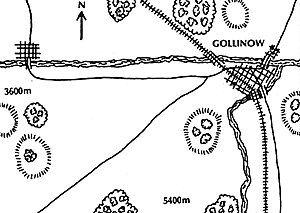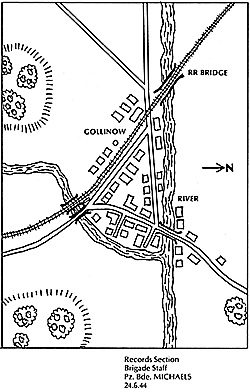 The following account has been compiled from interviews with officers and men of the Pz. Battalion Recon. Group, relating to the action in Gollinow:
The following account has been compiled from interviews with officers and men of the Pz. Battalion Recon. Group, relating to the action in Gollinow:
The recce unit (consisting of scout teams, a Panther platoon, HQ and engineers in march order) entered the Gollinow sector on the TanzGollinow road shortly after daybreak. Brigade HQ followed on the road. Deployed north and advancing in a parallel direction were 1st Platoon4th Pz Company (with PzJ IV/1 70) and 1st and 4th Platoons of the 2nd Grenadier Company; the remaining elements of these companies deployed south of the road.
We entered Gollinow across the western road bridge, and immediately made contact with the Company HQ of thetroops in Gollinow who were still holding the main bridge to the east of us. After posting the engineer section around the western bridge, the Panther platoon, supported by dismounted scout sections, began to advance along the axis of the rail line toward the eastern road bridge in order to secure it (Note: existing maps show this bridge almost due east of the others, but the actual direction appears to have been north-east). We had proceeded only a few hundred meters when we intercepted a messenger from the detail guarding the east bridge, telling us that the bridge had been lost and Soviet tanks were pouring across. (Apparently the bulk of the platoon assigned to secure this bridge had deployed east of the river as a delaying force, leaving a single squad to protect the PAK 38 at the bridge.
The PAK succeeded in disabling the first Soviet vehicle on the bridge, but Soviet SMG infantry surged across and overwhelmed the crew immediately after). A message from Brigade HQ on the hill west of town confirmed the entry of a Soviet T34/76 company into the town, but relayed that the bulk of the Soviet armor had moved further north.
The Recce commander then requested and received permission to immediately counterattack on a narrow front and recapture the bridge before further Soviet units could cross. Since the river appeared to be unfordable,the remaining units in this area were then to converge on the town and mop up the Soviet units cut off on our side of the river. Consequently, the engineers were ordered to dig in to defend the western bridge, the scout team was sent north through town to make contact with reinforcements entering to the northwest, and the Panther platoon, with Platoon HQ and 3 scout teams, headed toward the east road bridge. On arrival, the bridge was found undefended, but the lead tanks discovered a column of T34/85 approaching it and destroyed the lead two Soviet tanks on the bridge. This effectively blocked it for the remainder of the column which withdrew. A group of enemy APC's was seen moving south along the river bank from the area of the east bridge, and brief contact was made with some T34's in Gollinow, of which one was knocked out.
At this point heavy small-arms fire from the surrounding buildings indicated the presence of Soviet infantry, and we were preparing to withdraw toward the west bridge when a smoke screen fell on top of our lead tanks. The Panthers quickly pulled back into a leager to receive the expected enemy attack. (The Soviets in Gollinow had avoided the Panthers by moving into the northwest section of Gollinow, smashed the German reinforcements entering from this direction; they then deployed in an east-west line to counterattack before further German reinforcements could arrive).
 The enemy charge, accompanied by an attack from the river bank by the SMG units, created a critical situation; two platoons of grenadiers had just entered Gollinow and had not yet unloaded from their vehicles, and the PzJ IV/L70s behind them were taken in the flank as they crossed the bridge into town. Fortunately, these units recovered from their surprise, and the disorganization of the Soviet attack was its undoing. The infantry charging from the river ran into our grenadiers, which defended themselves from their carriers and halted the attack. Several enemy tanks were destroyed trying to bypass the Panther platoon (for the loss of one Panther), and many of the rest, without infantry support, fell to engineers and grenadiers.
The enemy charge, accompanied by an attack from the river bank by the SMG units, created a critical situation; two platoons of grenadiers had just entered Gollinow and had not yet unloaded from their vehicles, and the PzJ IV/L70s behind them were taken in the flank as they crossed the bridge into town. Fortunately, these units recovered from their surprise, and the disorganization of the Soviet attack was its undoing. The infantry charging from the river ran into our grenadiers, which defended themselves from their carriers and halted the attack. Several enemy tanks were destroyed trying to bypass the Panther platoon (for the loss of one Panther), and many of the rest, without infantry support, fell to engineers and grenadiers.
Two soldiers deserve special mention: Corporal Himmelman destroyed one tank at point-blank range by firing his panzerfaust from the crew compartment of his carrier; and another T34 which had approached within 50m of the western road bridge was KOed by Sergeant Zielinski, using a flamethrower; he subsequently led a party to capture a pair of T34s in running order.
These losses were too much for the Soviets, who broke and streamed back through the smoke or surrendered. Two tanks were surrounded by engineers, and the crews quickly dragged from their vehicles as the hatches opened; a third was destroyed as it tried to reverse out of action. The Soviet infantry melted back toward the river and presumably swam across to the enemy-held bank.
This last sharp fight turned out to be the end of the engagement as the Soviets did not renew their attacks as we regrouped. Losses were comparatively light given the severity of the action: one Panther, one scout team and several vehicles disabled by enemy tanks (in addition, 2 PzJ IV/L70, 2 Stummels and about a platoon of grenadiers were casualties); 9 T34 and one APC were destroyed, and two T34/76 captured in running order, numerous PPsh machine pistols and ammunition were recovered from the fleeing infantry.
More Accounts from the Front WWII Wargame Recaps
Back to Table of Contents -- Courier Vol. VII #5
To Courier List of Issues
To MagWeb Master Magazine List
© Copyright 1987 by The Courier Publishing Company.
This article appears in MagWeb (Magazine Web) on the Internet World Wide Web.
Other military history articles and gaming articles are available at http://www.magweb.com